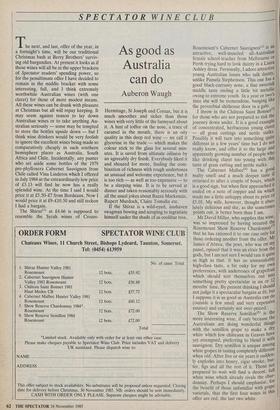SPECTATOR WINE CLUB
The next, and last, offer of the year, in a fortnight's time, will be our traditional Christmas bash at Berry Brothers' surviv- ing old burgundies. At present it looks as if these wines will all be in the upper brackets of Spectator readers' spending power, so for the penultimate offer I have decided to remain in the middle bracket with some interesting, full, and I think extremely worthwhile Australian wines (with one claret) for those of more modest means. All these wines can be drunk with pleasure at Christmas but all will repay keeping. It may seem against reason to lay down Australian wines or to take anything Au- stralian seriously — some may be tempted to store the bottles upside down — but I think wine drinkers would be very foolish to ignore the excellent wines being made so comparatively cheaply in such southern hemisphere places as Australia, South Africa and Chile. Incidentally, any punter who set aside some bottles of the 1979 pre-phylloxera Cabernet Sauvignon from Chile called Vina Linderos which I offered in July 1984 at the extraordinarily low price of £3.13 will find he now has a really splendid wine. At the time I said I would price it at £5.5047 from Bordeaux. Now I would price it at £9410.50 and still reckon I had a bargain. The Shirai" at £4.66 is supposed to resemble the Syrah wines of Crozes-
As good as Australia can do
Auberon Waugh
Hermitage, St Joseph and Comas, but it is much smoother and richer than those wines with very little of the farmyard about it. A hint of toffee on the nose, a trace of caramel in the mouth, there is an oily quality in this deep red wine — we call it glycerine in the trade — which makes the colour stick to the glass for several min- utes. It is saved from ultimate oiliness by an agreeably dry finish. Everybody liked it and shouted for more, finding the com- bination of richness with rough undertones an unusual and welcome experience, but it is too rich — as well as too expensive — to be a slurping wine. It is to be served at dinner and taken reasonably seriously with all the usual jokes about Bazza Mackenzie, Rupert Murdoch, Claire Tomalin etc.
If the Shiraz is a wild-eyed, 'Unshaven swagman bowing and scraping to ingratiate himself under the shade of as coolibar tree, Rosemount's Cabernet Sauvignon(2) is an attractive, well-muscled all-Australian female school-teacher from Melbourne or Perth trying hard to look dainty in a Laura Ashley dress. Personally, I adore attractive young Australian lasses who talk dainty, unlike Pamela Stephenson. This one has a good black-curranty nose, a fine sweetish middle taste ending a little bit metallic owing to extreme youth. In a year or two's time she will be tremendous, banging like the proverbial shithouse door in a gale. 3, I throw in the Château Saint Bonnet for those who are not prepared to risk the journey down under. It is a good example of concentrated, herbaceous young claret — all grass cuttings and nettle stalks. Possibly it will turn into something quite different in a few years' time but I do not really know, and offer it to the large and apparently growing number of people who like drinking claret too young with this taste of grass cutting and nettle stalks. The Cabernet Malbec(4) has a good malty smell and a much deeper taste if returned to after a couple of hours, which is a good sign, but when first approached it ended on a note of copper and tin which made me a little unhappy about its price of £5.01. My wife, however, thought it abso- lutely delicious and she, as she sometimes points out, is better born than I am.
Mr David Miller, who supplies this wine, was so impressed by having secured the Rosemount Show Reserve Chardonnay( that he has rationed it to one case only for those ordering another from the offer. Mr James d'Abreu, the poet, who was on tnY panel, opined that it was an elixir from the gods, but I am not sure I would rate it quite as high as that. It has an unmistakably high-class taste, a bit oaky for my own preferences, with undertones of grapefruit which should sort themselves out into something pretty spectacular in six or 12 months' time. By present drinking I should not judge it a spectacular bargain at £6, but I suppose it is as good as Australia can do (outside a few small and very expensive estates) and certainly not over-priced. The Show Reserve Semillon(6) is the more interesting wine, if only because the Australians are doing wonderful things with the semillon grape to make a dry white which few châteaux in Graves have yet attempted, preferring to blend it with sauvignon. Dry semillon is unique among white grapes in tasting completely different when old. After five or six years it sudden- ly explodes into honey, cigar smoke, but- ter, figs and all the rest of it. Those not prepared to wait will find a decent, full white wine which already rivals the dial' donnay. Perhaps I should emphasise, for the benefit of those unfamiliar with grape varietals, that the first four wines in this offer are red, the last two white.


































































 Previous page
Previous page